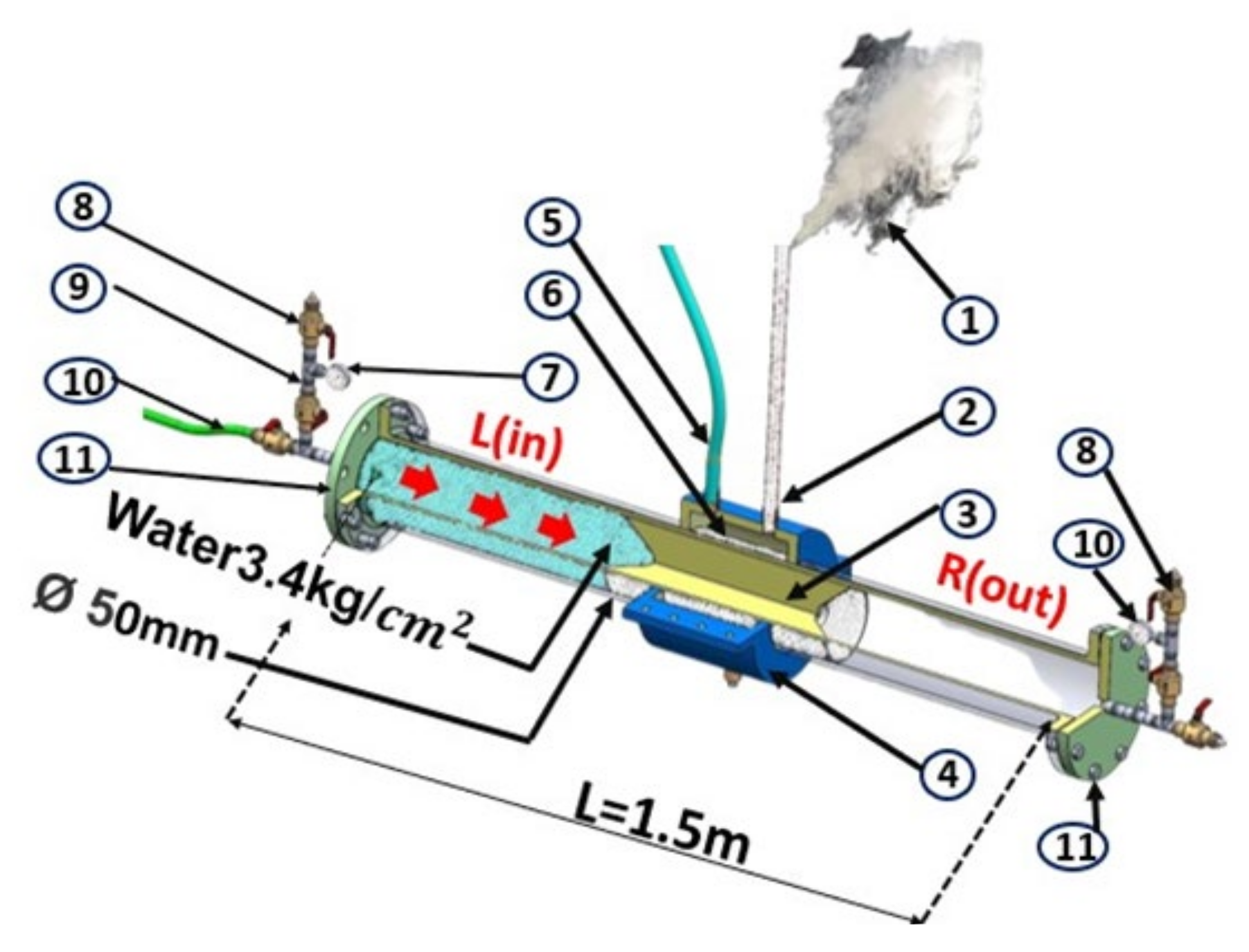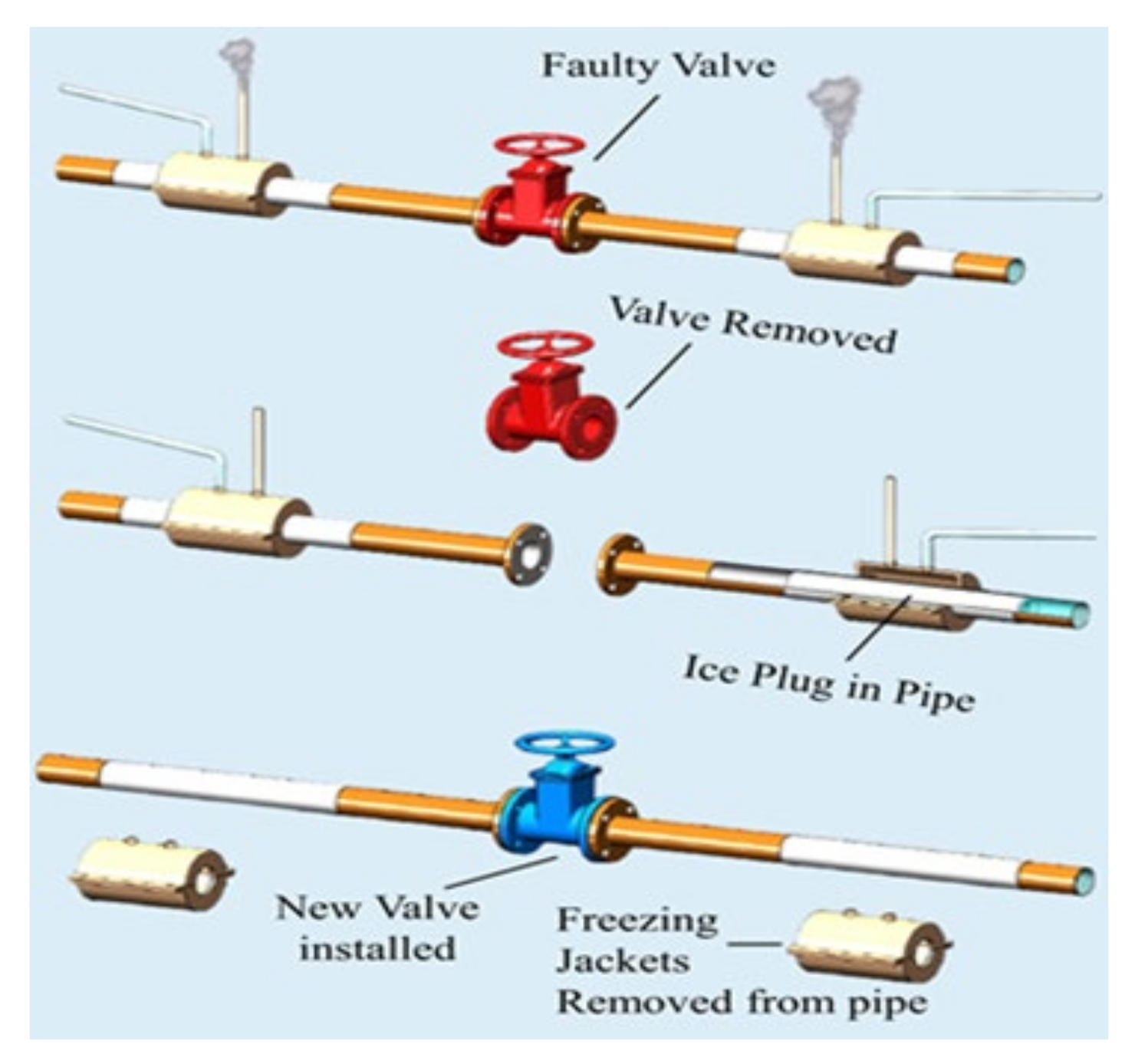An Efficient No-Shutdown Pipe-Fixing Freezing Design for Water Management System in Hospitals during COVID-19: A Case Study
Abstract
:1. Introduction
2. Materials and Methods
3. Data Analysis and Case Study
3.1. Experimental Data Analysis
3.2. Case Study
4. Conclusions and Discussion
5. Patents
Author Contributions
Funding
Data Availability Statement
Acknowledgments
Conflicts of Interest
Nomenclature
| A | area |
| kg | Kilogram (basic unit of mass) |
| cm | centimeter (unit of displacement) |
| T | temperature (degree of heat present in a substance or object) |
| °C | degree Celsius (unit used to measure temperature) |
| min | minute |
| t | time |
| cm2 | square centimeter |
| mm | millimeter |
| ~ | approximately |
| D | diameter |
| LN2 | liquid nitrogen |
References
- Tan, Y. COVID-19: What Went Wrong in Singapore and Taiwan? Available online: https://www.bbc.com/news/world-asia-57153195 (accessed on 20 May 2021).
- Das, S.; Kaur, S.; Jutla, A. Earth Observations Based Assessment of Impact of COVID-19 Lockdown on Surface Water Quality of Buddha Nala, Punjab, India. Water 2021, 13, 1363. [Google Scholar] [CrossRef]
- Paudel, S.; Kumar, P.; Dasgupta, R.; Johnson, B.A.; Avtar, R.; Shaw, R.; Mishra, B.K.; Kanbara, S. Nexus between Water Security Framework and Public Health: A Comprehensive Scientific Review. Water 2021, 13, 1365. [Google Scholar] [CrossRef]
- Kalbusch, A.; Henning, E.; Brikalski, M.P.; Luca, F.V.D.; Konrath, A.C. Impact of coronavirus (COVID-19) spread-prevention actions on urban water consumption. Resour. Conserv. Recycl. 2020, 163, 105098. [Google Scholar] [CrossRef] [PubMed]
- Balacco, G.; Totaro, V.; Iacobellis, V.; Manni, A.; Spagnoletta, M.; Piccinni, A.F. Influence of COVID-19 Spread on Water Drinking Demand: The Case of Puglia Region (Southern Italy). Sustainability 2020, 12, 5919. [Google Scholar] [CrossRef]
- WatEner. Wasserverbrauch und Bedarfsprognose während der COVID-19-Krise. Available online: http://watener.com/index.php/wasserverbrauch-und-bedarfsprognose-wahrend-der-COVID-19-krise/?lang=de (accessed on 30 November 2020).
- Cooper, R. Water Security Beyond COVID-19; Unversity of Brimingham: Brimingham, UK, 2020. [Google Scholar]
- Howard, G.; Bartram, J.; Brocklehurst, C. COVID-19: Urgent actions, critical reflections and future relevance of ‘WaSH’: Lessons for the current and future pandemics. J. Water Sanit. Hyg. Dev. 2020, 18. [Google Scholar] [CrossRef]
- World Bank Group. Reducing Inequalities in Water Supply, Sanitation, and Hygiene in the Era of the Sustainable Development Goals; World Bank: Washington, DC, USA, 2017. [Google Scholar]
- Intemann, P.A.; Kazmierczak, M. Heat Transfer and Ice Formations Deposited upon Cold Tube Bundles Immersed in Flowing Water—I. Convective analysis. Int. J. Heat Mass Transf. 1997, 40, 557–572. [Google Scholar] [CrossRef]
- Habeebullah, B.A. An Experimental Study on Ice Formation around Horizontal Long Tubes. Int. J. Refrig. 2007, 30, 789–797. [Google Scholar] [CrossRef]
- Cheng, K.C.; Inaba, H.; Gilpin, R.R. Effects of Natural Convection on Ice Formation around an Isothermally Cooled Horizontal Cylinder. J. Heat Transf. 1988, 110, 931–937. [Google Scholar] [CrossRef]
- Hirata, T.; Matsui, H. Ice Formation and Heat Transfer with Water Flow around Isothermally Cooled Cylinders Arranged in a Line. J. Heat Transf. 1990, 112, 707–713. [Google Scholar] [CrossRef]
- Stampa, C.S.; Nieckele, A.O. Numerical Study of Ice Layer Growth around a Vertical Tube. Therm. Eng. 2005, 4, 138–144. [Google Scholar] [CrossRef]
- Sparrow, E.M.; Bahrami, P.A. Experiments on Natural Convection Heat Transfer on the Fins of a Finned Horizontal Tube. Int. J. Heat Mass Transf. 1980, 23, 1555–1560. [Google Scholar] [CrossRef]
- Burton, M.J. An experimental and Numerical Study of Plug Formation in Vertical Pipes during Pipe Freezing. Ph.D. Thesis, University of Southampton, Southampton, UK, 1986. [Google Scholar]
- Tavner, A.C.R. An Experimental Study of Ice Formation and Convection during Cryogenic Pipe Freezing. Ph.D. Thesis, University of Southampton, Southampton, UK, 1992. [Google Scholar]
- Bowen, R.J.; Burton, M.J.; Smith, G.S. The effect of pipe diameter and pressure drop on the formation of ice plugs in pipelines. In Proceedings of the Ninth International Heat Transfer Conference, Jerusalem, Israel, 19–24 August 1990. [Google Scholar]
- Hu, X.; Guo, W.; Zhang, L.; Wang, J. Application of Liquid Nitrogen Freezing to Recovery of a Collapsed Shield Tunnel. J. Perform. Constr. Facil. 2014, 28, 04014002. [Google Scholar] [CrossRef]
- Choi, H.J.; Won, J.; Lee, D.; Lee, H. Effect of Ground Freezing with Liquid Nitrogen on Freezing Rate and Mechanical Properties of Coastal Clayey Silt. J. Eng. Mech. 2021, 147, 04021057. [Google Scholar] [CrossRef]
- Sudisman, R.A.; Osada, M.; Yamabe, T. Experimental Investigation on Effects of Water Flow to Freezing Sand around Vertically Buried Freezing Pipe. J. Cold Reg. Eng. 2019, 33, 04019004. [Google Scholar] [CrossRef] [Green Version]
- Cai, H.; Li, P.; Wu, Z. Model Test of Liquid Nitrogen Freezing-Temperature Field of Improved Plastic Freezing Pipe. J. Cold Reg. Eng. 2020, 34, 04020001. [Google Scholar] [CrossRef]
- Liu, F.L.; Chiang, T.Y. Application of a Frozen Ice Blocked Pipe Water Method to Non-Shutdown Repairing Work of Water Supply System. Patent No. TW201938923A, 1 October 2019. [Google Scholar]








| No. of Sensor | T1 | T2 | T3 | T4 | T5 | T6 | T7 |
|---|---|---|---|---|---|---|---|
| Distance to water pipe centerline (cm) | 70 | 65 | 80 | 95 | 110 | 50 | 130 |
| Temperature (°C) | Freezing Time (min.) | Liquid Nitrogen Using (kg) |
|---|---|---|
| 30 | 30 | 21.8 |
| 20 | 20 | 13.8 |
| 10 | 15 | 12.0 |
| 5 | 13 | 10.1 |
Publisher’s Note: MDPI stays neutral with regard to jurisdictional claims in published maps and institutional affiliations. |
© 2021 by the authors. Licensee MDPI, Basel, Switzerland. This article is an open access article distributed under the terms and conditions of the Creative Commons Attribution (CC BY) license (https://creativecommons.org/licenses/by/4.0/).
Share and Cite
Liu, F.-L.; Fan, S.-K.S.; Ndi, E.; Tu, J.-F. An Efficient No-Shutdown Pipe-Fixing Freezing Design for Water Management System in Hospitals during COVID-19: A Case Study. Water 2021, 13, 2725. https://doi.org/10.3390/w13192725
Liu F-L, Fan S-KS, Ndi E, Tu J-F. An Efficient No-Shutdown Pipe-Fixing Freezing Design for Water Management System in Hospitals during COVID-19: A Case Study. Water. 2021; 13(19):2725. https://doi.org/10.3390/w13192725
Chicago/Turabian StyleLiu, Fei-Lung, Shu-Kai S. Fan, Ebede Ndi, and Jih-Fu Tu. 2021. "An Efficient No-Shutdown Pipe-Fixing Freezing Design for Water Management System in Hospitals during COVID-19: A Case Study" Water 13, no. 19: 2725. https://doi.org/10.3390/w13192725
APA StyleLiu, F.-L., Fan, S.-K. S., Ndi, E., & Tu, J.-F. (2021). An Efficient No-Shutdown Pipe-Fixing Freezing Design for Water Management System in Hospitals during COVID-19: A Case Study. Water, 13(19), 2725. https://doi.org/10.3390/w13192725







